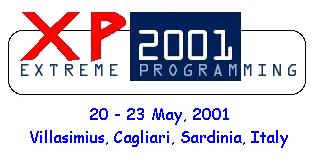 |
 |
||
 |
 |
||




How do well sell XP projects and make sure we get paid? There are many technicians and managers who believe in XP but are unclear how to get such projects signed off by the people with budgets — and keep them happy once they've done so.
Many potential sponsors will see a new methodology as unnecessary risk compared to traditional, fixed cost and functionality contracts. We need to convince these people that XP is a better way to go, even if some the practices seem counter-intuitive. Once we have a sponsor, we must guide them through the process and make sure they feel the benefits — while avoiding the old traps that lurk in the murky (but very human) world of corporate management. In short, we must get them to buy into our value proposition, and then make sure they get and understand the value.
This session will provide a forum for the community to share our experiences, successful or otherwise. The session will start with brief introductions from several people who have been concerned with this issue in their organisations, and then open up to a discussion amongst the audience. The session will be run as a Goldfish Bowl, a process designed to manage discussions with large groups of people.
Selling the first XP project into an organization can be difficult. XP contradicts some of the received wisdom of current software practice and, critically, many organizations' contract awarding procedures. The essential questions most purchasers want to answer are "how much will this cost", "what will I get for my money" and, "when will my system be completed?" Their contract organizations are looking for a contract that spells out specific deliverables in detail. Lurking just below the surface is "what cover do I have if it goes wrong"? The conventional XP response is "just give me three weeks", but for many organizations a few people for three weeks is too large an opportunity cost — even if we know that it will be more effective. How have members of the community managed to get XP projects commissioned?
Second, having sold an XP project, what do we need to do to ensure its success? Curiously, in our industry, delivery and success are not always the same thing. XP is unusual in the degree to which it exposes issues and contradictions in a project, and some organizations are not equipped to cope with this. At the very least, it will require the client to change their interaction with, and their management expectations of, the project team - and changing corporate behavior can be even more difficult than getting sign-off in the first place. What a team delivers at the end of a series of iterations can be quite different from what the client thought they first agreed to. Will this lead to problems getting the next project or, for outsiders, our invoices paid? Have any of us found that this has brought down a project?
Finally, if we really are delivering better value, how do we ensure that customers realize it? How do we get them to pay an appropriate premium?
Some questions that we might consider are:
The format of the session will be an adapted Goldfish Bowl. A Goldfish Bowl is a process designed to manage an open discussion in a large group of people. There are a small number of seats in the middle and only the occupants of those seats may talk. Speakers who have run out of things to say, or would like to take a break, leave their seat and anyone else from the audience can take their place; speakers can return later when another chair opens up. There is also a moderator who introduces the session and can evict speakers if the discussion needs to be moved on. This Goldfish Bowl will be seeded by the speakers listed below; each will give a brief (5 minutes) talk to describe their experiences with the topic, then the session will be opened up to the audience.
The purpose of the session is to share the experiences of the whole community. The advantage of a Goldfish Bowl is that it allows everyone in the audience to contribute without always referring back to a panel. It also avoids a potential weakness of panel sessions that, once the initial positions have been taken, the rest of the session is predictable.
Kevin Tyson is Chief Technology Officer with Financial Services Architects Mr. Tyson has spent the last 25 years making computers do useful things for business people in the Capital Markets business. His work has included building e-commerce systems for retail equities trading, large scale funds transfer systems and numerous back-office applications. This work has been done primarily on Wall Street.
Tom Pardee is a Principal Consultant and eBusiness Strategist at Paragon Computer Professionals, a 1,000+ staff eBusiness consulting company on the US Eastern seaboard. Tom supports the projects division of Paragon with expertise in RFP evaluation, eBusiness paradigms, new technologies, application architecture, development methodologies, and marketing. He has introduced a fixed-cost variant of XP and directed a demonstration engagement. He has over 20 years experience in consulting.
Roy Miller is Director of Business Relationships at RoleModel Software, Inc. in Holly Springs, NC. In late 1998, RoleModel Software began building the first eXtreme Programming Software Studio(TM). This is a place where apprentices, skilled journeyman, and software masters work together in an environment of continuous learning with extremely effective modes of collaboration to produce unusually adaptable and robust software for its clients.
John Nolan has been working in technology for over ten years in engineering, finance and software. In recent years, he has been heavily involved in bringing secure electronic commerce systems to the Internet as Chief Architect of Interworld Technology Ventures and, directly before co-founding Connextra, for Dresdner Kleinwort Benson. John is CTO of Connextra and leads the technology team behind Sidewize.
Kay Johansen is a senior programmer with experience developing office productivity and accounting software at WordPerfect?, Merasoft and e-automate. She has created and conducted internal training courses on software process, object oriented programming and design patterns. At e-automate she led and coached the adoption of Extreme Programming in a start-up, shrink-wrap environment. She has degrees in electrical engineering and mathematics.
Steve Freeman is a Principal Consultant at Big Blue Steel Tiger, where he develops e-commerce solutions. He is also responsible for coaching Extreme Programming within Big Blue Steel Tiger. Prior to this, he ran largest XP project in the UK at Lombard Risk Systems. He has degrees in Statistics and Music, and a PhD in computer science from Cambridge University. He has written software for research labs, shrink-wrap and bespoke systems.

